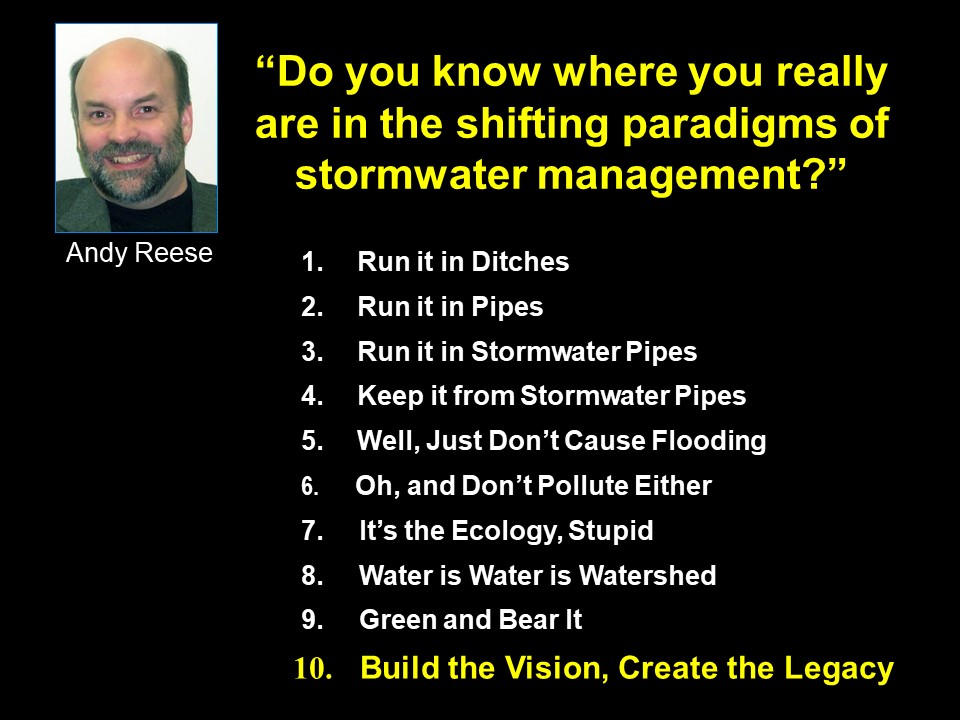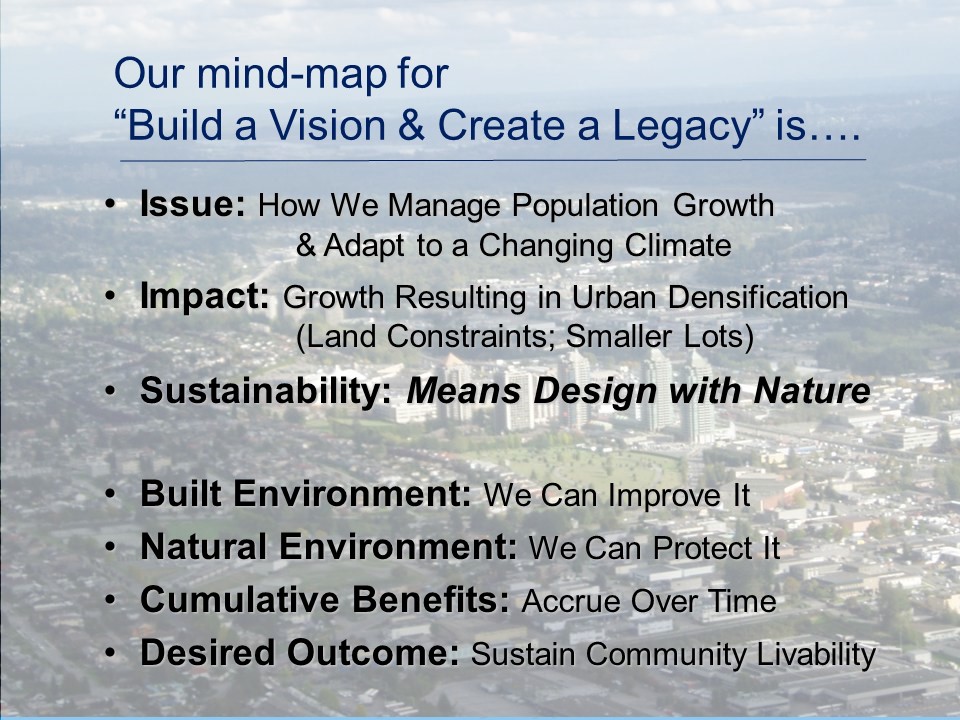FLASHBACK TO 2008 / MAKE GREEN CHOICES TO PROTECT STREAM HEALTH: “Rather than evolution, the approach to stormwater management over the last couple of decades might be better described as ‘reactionary’ in response to a realization that old ways of doing business were causing harm,” stated Ian Whitehead at Seminar 1 in the inaugural Comox Valley Learning Lunch Series when he provided a historical retrospective on the evolution of drainage practices in the City of Courtenay (YouTube Video)
Note to Reader:
In 2008, Vancouver Island was the pilot region for a collaborative and inclusive approach to practitioner continuing education. A key objective was to establish consistency at local front counters so that developers and development consultants hear a consistent message as to what is expected of them regarding rainwater management and green infrastructure.
The Comox Valley Learning Lunch Seminar Series was an integral part of this provincial initiative. The implementation program built on the foundation provided by Stormwater Planning: A Guidebook for British Columbia, published in 2002, and incorporated lessons learned about the challenges in moving from planning to action during the 6-year period following release of the Guidebook.

Create Liveable Communities and Protect Stream Health:
East Courtenay Case Study
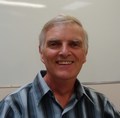 “We featured the east Courtenay area in the first seminar because this part of the city has evolved from fields and forest over the past two decades, and so has our approach to stormwater and rainwater management. We incorporated a walkabout at the front-end of the seminar program so that participants would have a visual frame of reference for concepts that will be covered in the curriculum for the second and third seminars,” explained Kevin Lagan, Director of Operational Services for the City of Courtenay.
“We featured the east Courtenay area in the first seminar because this part of the city has evolved from fields and forest over the past two decades, and so has our approach to stormwater and rainwater management. We incorporated a walkabout at the front-end of the seminar program so that participants would have a visual frame of reference for concepts that will be covered in the curriculum for the second and third seminars,” explained Kevin Lagan, Director of Operational Services for the City of Courtenay.
From Fields and Forest to Urban Community
Ian Whitehead’s then 20-year history as the City’s consultant of record provided a historical retrospective on the evolution of drainage practices in east Courtenay. His presentation set the scene for a walkabout through the Glacier View Pond area. The walkabout provided an on-the-ground illustration of how the engineering approach to detention pond design has evolved in response to changing expectations.
 Ian Whitehead’s storyline was organized in three parts. In the first 10-minutes, he introduced the evolution theme and drew on his experience over 20 years to provide context for the Glacier View case study. He reflected on changes in drainage practice as he has implemented in East Courtenay over the past two decades.
Ian Whitehead’s storyline was organized in three parts. In the first 10-minutes, he introduced the evolution theme and drew on his experience over 20 years to provide context for the Glacier View case study. He reflected on changes in drainage practice as he has implemented in East Courtenay over the past two decades.
In the second 10-minutes, Ian Whitehead delved into the next level of detail in terms of illustrating what the evolution in drainage practices looks like on the ground in Courtenay. His emphasis was on how to achieve a water balance through ground infiltration of rainwater runoff.
In the final 9-minutes, he set the stage for the walkabout by describing the elements of the Glacier View case study. He presented a series of slides taken during construction, completed in 2008.

Evolution or Reaction?
“In my presentation, I have intertwined two related themes. The first is the evolution of watershed management and stormwater management to rainwater management. And secondly, the evolution of the Glacier View catchment in East Courtenay, and how those principles and practices have been applied,” stated Ian Whitehead.
“In preparing this presentation, I looked up the definition of evolution in my pocket dictionary. It says develop, or cause to develop gradually. It goes on to say that this means undergo slow changes in the process of growth. By this definition, at least, I would argue that what has been going on in this part of the world is something other than evolutionary. Over the last 15 to 20 years, we have seen dramatic changes in the Comox Valley in land use and the effects of stormwater and rainwater on the environment.”
“Realistically, evolution is not the right word. As engineers and planners, we are reacting to what we perceive as adverse conditions. That’s human nature; that’s what happens when we have our backs against the wall with conditions that we find objectionable. We change our ways, and that is where we are going with (rainwater management). We are changing our perspective of how to deal with land development and the watersheds within which projects are situated.”
“As my dad told me, there are three types of people in this world. There are dummies that never learn. There are pretty smart people who learn from their mistakes. And then there are the really smart people who learn from the mistakes of others. The intent in this seminar is that we put ourselves in that last category.”
Ian Whitehead on YouTube:
Download the PowerPoint presentation by Ian Whitehead which is titled The Story of East Courtenay over the past two decades: from fields and forest to urban community. Then watch the video of Ian Whitehead tell his story on YouTube.
East Courtenay – this is now, and that was then
The featured image in the YouTube video (above) is an aerial photo taken circa 2008. This compares with the aerial photo below from 1964. This comparison illustrates the change from fields and forest to urban community. The remaining area of forest is protected as parkland.
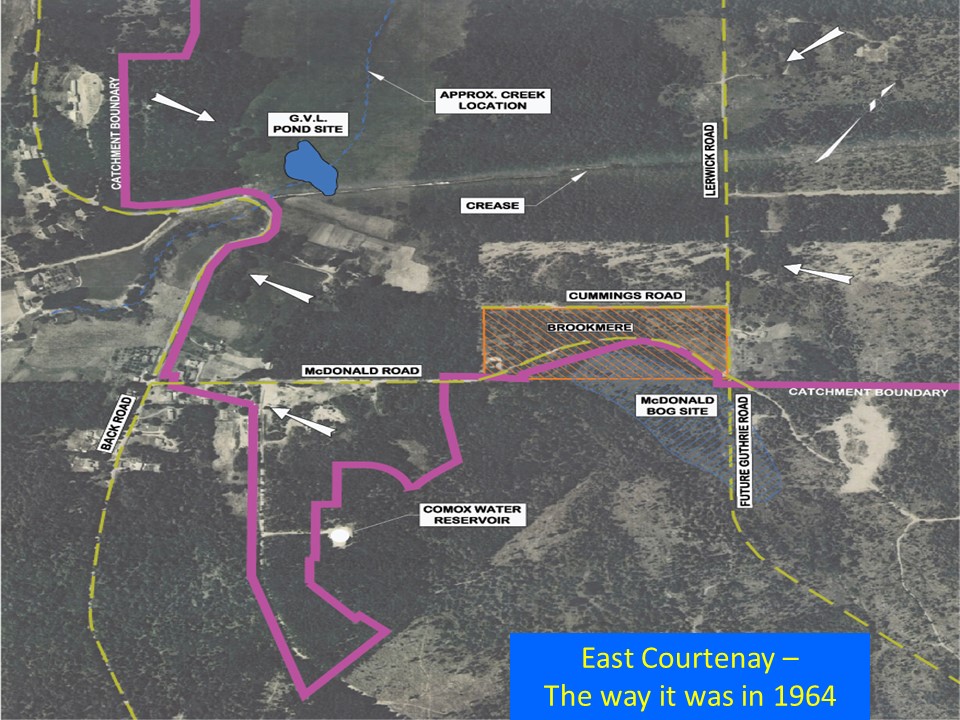
Walkabout – YouTube Videos
To view a set of videos taken at points of interest along the the walkabout route, click on this link to EXPECTATIONS EVOLVE OVER TIME: A walkabout through the Glacier View Pond Area illustrated changes in rainwater management practice in the City of Courtenay (September 2008).
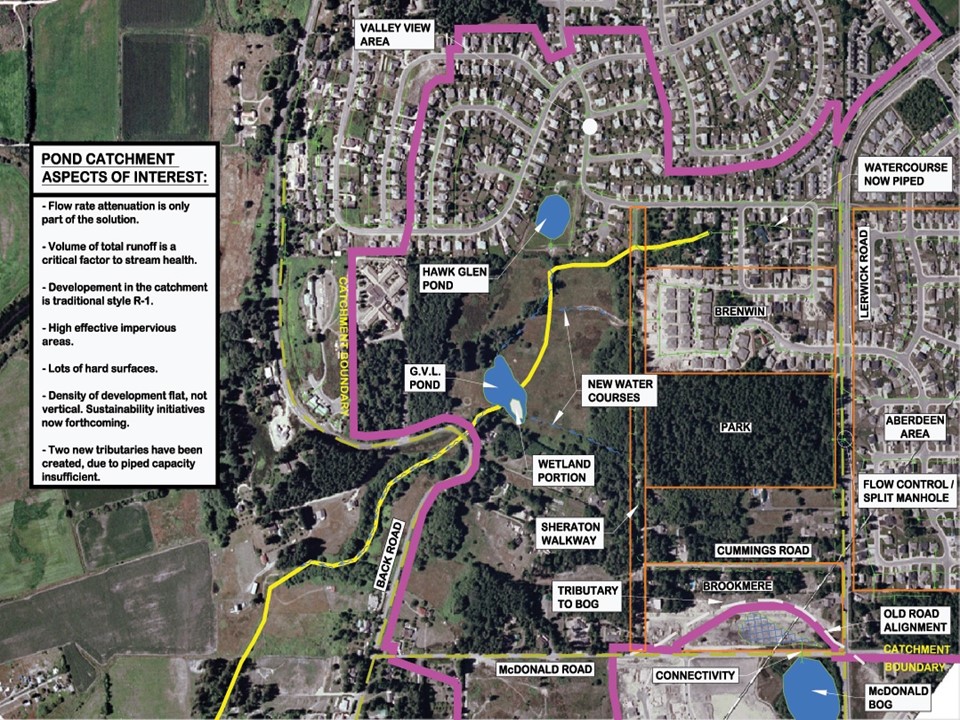
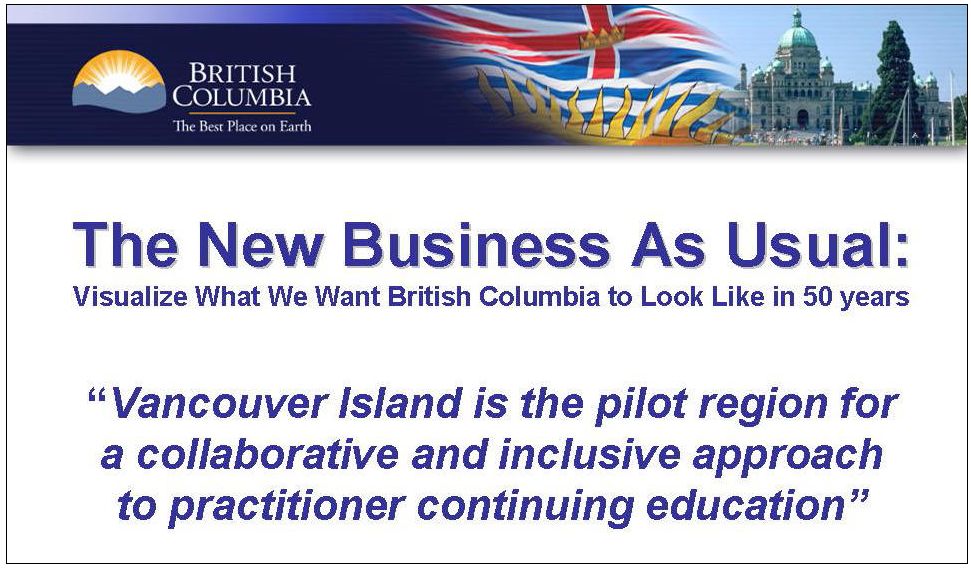
2008 Comox Valley Seminar Series:
Change the Way We Develop Land
The Comox Valley series comprised a set of three sessions held during the September through November 2008 period. The three seminars were designed to provide an inter-departmental and inter-municipal learning opportunity for collaborative exploration.
The series was conducted as a cumulative process, from philosophy to tools, in order to advance a regional team approach to rainwater management and green infrastructure. Each session started at 11:00am and ended at 3:00pm.
“The City of Courtenay decided to host the inaugural series because we saw it as an exciting opportunity to further advance a regional team approach in the Comox Valley. Our goal was to demonstrate how we can all do business differently and thereby make green choices that create liveable communities and protect stream health,” stated Kevin Lagan.
Beyond the Guidebook Initiative
The evolution of planning for water sustainability by implementing green infrastructure achieved a milestone with release of Beyond the Guidebook: Context for Rainwater Management and Green Infrastructure in British Columbia in June 2007. This was followed by the first Beyond the Guidebook Seminar, held in November 2007.
In early 2008, the provincial government’s Speech from the Throne provided a timely impetus for branding Beyond the Guidebook as The New Business As Usual and rolling it out through the Learning Lunch Series.”
An announcement by Dale Wall, Deputy Minister (Community Development) at the Gaining Ground Summit in May 2008 then underscored the Province’s commitment. But it was the release of Living Water Smart, BC’s Water Plan, in June 2008 that provided clear provincial policy direction for doing business differently.
To Learn More:
Visit the homepage for the 2008 Comox Valley Series https://waterbucket.ca/viw/category/convening-for-action-in-2008/2008-comox-valley-learning-lunch-seminar-series/
Download a copy of The Story of the 2008 Vancouver Island Learning Lunch Seminar Series. This summary report comprises seven chapters:
- Greening the Built Environment
- Genesis of Vancouver Island Learning Lunch Seminar Series
- Living Water Smart, BC’s Water Plan
- Beyond the Guidebook: The New Business As Usual
- Learning Lunch Curriculum
- Overview of Series Outcomes
- A Positive Settlement Strategy for Vancouver Island
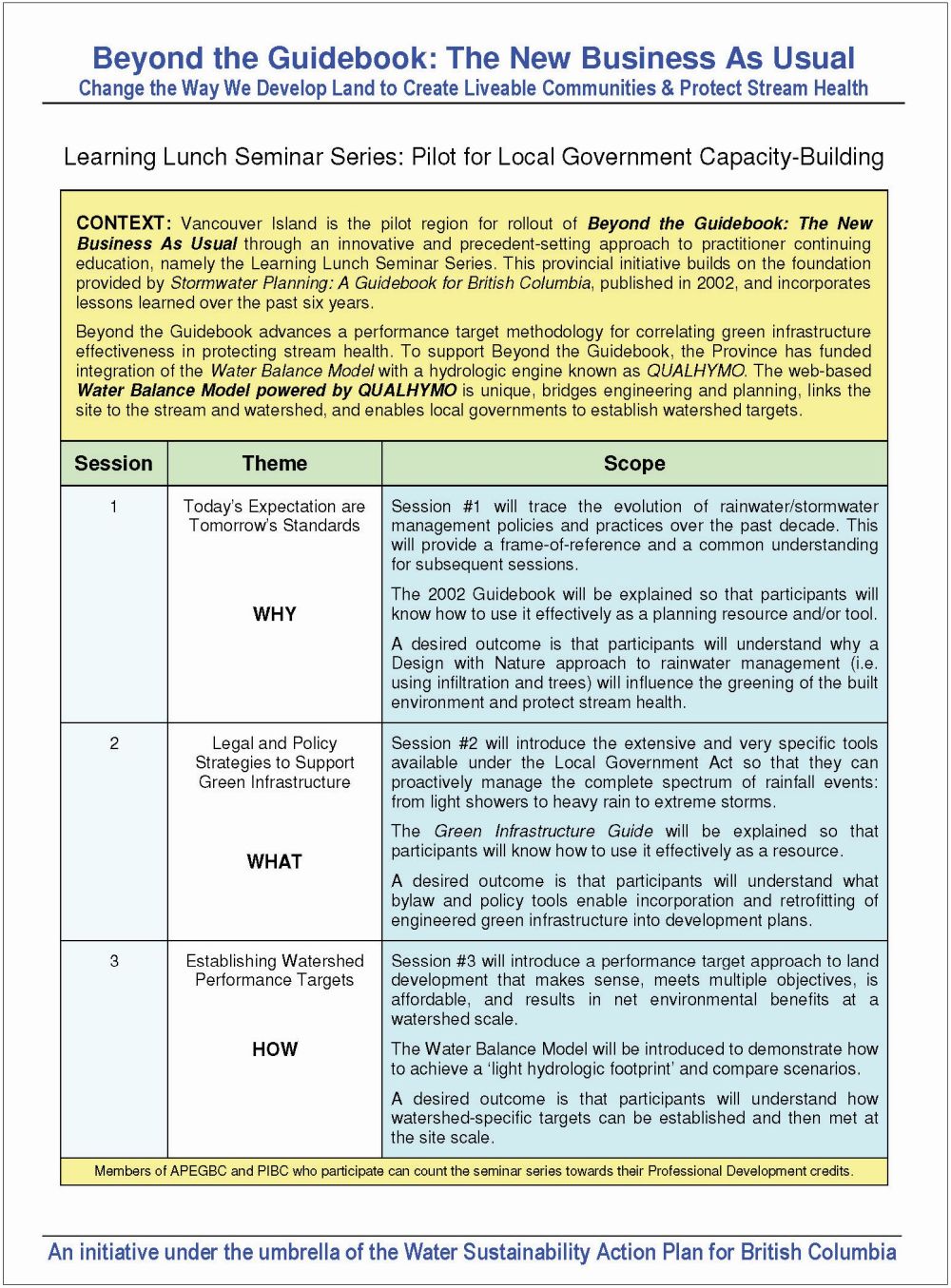
Evolution of Drainage Engineering Practice Over Time:
Andy Reese’s “Continuum of Stormwater Paradigms”
In 2001, an American engineer and author named Andy Reese introduced the concept of a continuum of stormwater paradigms. People and communities progress at different rates along the continuum – nearby communities in the same region may even be guided by different paradigms. This provides context for the East Courtenay experience.
Paradigm-Shift to Rainwater Management
 “By the end of the 1990s, it was becoming clear that managing floods alone was insufficient as a drainage engineering objective. We actually needed to manage all the events on the runoff continuum. This realization ushered in the ‘rainwater management’ era in the first decade of the 21st century. In 2002, with publication of Stormwater Management: A Guidebook for British Columbia, the Province signaled a new direction for drainage engineering practice,” stated Kim Stephens, team leader for the Vancouver Island Learning Lunch Seminar Series.
“By the end of the 1990s, it was becoming clear that managing floods alone was insufficient as a drainage engineering objective. We actually needed to manage all the events on the runoff continuum. This realization ushered in the ‘rainwater management’ era in the first decade of the 21st century. In 2002, with publication of Stormwater Management: A Guidebook for British Columbia, the Province signaled a new direction for drainage engineering practice,” stated Kim Stephens, team leader for the Vancouver Island Learning Lunch Seminar Series.
“The Guidebook set in motion a chain of outcomes that resulted in British Columbia being recognized internationally as a leader in implementing a natural systems approach to rainwater management in the urban environment. One of the lessons learned was the need for a program that would ensure province-wide consistency in understanding of approaches and desired outcomes.”
“Andy Reese identified nine paradigms in his 2001 article. The awareness generated by article publication provided us with timely inspiration to brand the Guidebook approach as representing the Tenth Paradigm. To draw attention to desired outcomes, we branded the Tenth Paradigm as Build the Vision, Create the Legacy. In retrospect, it was serendipity the way things came together, in particular because we were breaking new ground with the water balance methodology and all that it entailed.”
“We introduced the the phrase ‘design with nature’ so that participants would understand why a Design With Nature approach to rainwater management, using infiltration and trees, will influence the greening of the built environment and protect stream health. These are the desired outcomes that would sustain community livability!”
To Learn More:
To read the article, click on this link to Do you know where you really are in the shifting paradigms of stormwater management?
